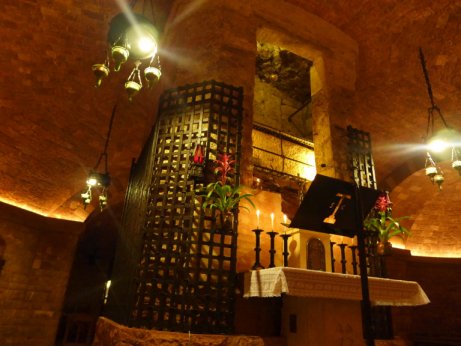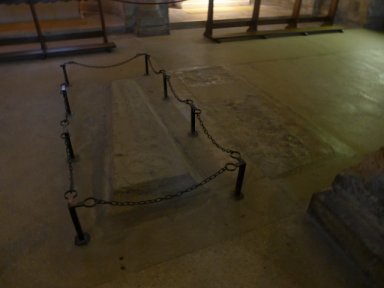|
San Francesco, Assisi - Lower Church |
|
Crypt |
|
|
| The relics of St. Francis are
preserved in a stone sarcophagus above the altar. The sarcophagus dates
from the Roman period. The story of these relics is not a straightforward one. He died on October 3, 1226, and on July 16, 1228 he was canonised by Pope gregory IX. His 'uncorrupt' body was moved to the basilica on May 25, 1230. At this point the story becomes rather complicated, more Dan Bown than straight ecclesiastical history. Donal Cooper's paper, The Tomb of St Francis in history, Legend and Art* does an excellent job in sorting out the archaeological and documentary evidence from the myths about secret passages, skullduggery by one Brother Elias, and arcane knowledge as the whereabouts of the relics known only to a chosen few. There were genuine concerns for the safety of the relics - saints relics were a valuable commodity, and, apart from the risk from raiding Saracens, those wretched Perugians might have had designs on it. Consequently, the body was eventually hidden in loco tutissimo et firmissio, sealed in solid rock somewhere beneath the high altar. The years passed and, rather like the relics of St. Mark in Venice, the Friars forgot where they had put them. They didn't turn up again until 1818, following excavations into that solid rock beneath the basilica. Strangely, amongst the items found with the relics were eleven silver coins dating from the twelfth century from the mint of Otto IV - identical coins were found with the relics of St. Mark! These coins were taken as evidence of the authenticity of the remains. In 1978 the remains were examined by scholars who agreed with this identification. The sarcophagus remained where it was found, and the crypt around it was begun in 1824. It seems that the neo-classical style did not go down well. It was redesigned in the nineteen-twenties and finally completed in 1932. An aside: lost relics. There is a curious connection between three sets of sacred relics; those of St Francis in Assisi, St Mark in Venice, and St Thomas Becket in Canterbury. I have already mentioned the co-incidence of the forgotten location and the coins in the stories of St Francis and St Mark. In both cases there was a legend that only a chosen few knew where the relics were; in the case of St Francis, one of them was the Pope. In both cases the information got lost. In Venice, St Mark himself took a hand in finding them again; St Francis had to rely on archaeologists. Strangely, the same legend is told about the relics of Thomas Becket. It is generally believed that they disappeared at the time of the reformation, along with other 'superstitious abominations.' Not everyone believes this. Some believe that the relics were hidden away, and to this day an inner circle in Canterbury knows where in the cathedral they are. Where might that be? Could it be here? |
|
|
The Quest for Becket's Bones by John Butler is a fascinating read. Recommended! |
In The Art of the Franciscan Order in Italy edited by William Robert Cook, Brill, 2005. |
|
Back to San Francesco Lower Church page 1 Home page - explore the site |

